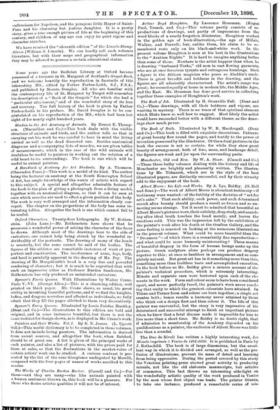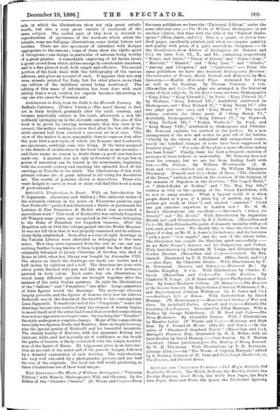Albert Moore : his Life and Works. By A. Lys.
Baldry. (G. Bell and Sons.)—The work of Albert Moore is abundant testimony—if testimony were wanted—of the futility of the doctrine of "art for art's sake." That such ability, such power, and such determined search after beauty should produce a result so frozen and so un- moving seems strange. Yet it must be admitted that beautiful as Albert Moore's pictures were, their subtlety, deep study, and search- ing after ideal truth touches the head merely, and leaves the emotions cold. This was the impression left by the exhibition of the painter's work after his death at the Grafton Gallery, and the same feeling is renewed on looking at the numerous illustrations in the present volume. What could be more beautiful than the "Dreamers "—of which there is a remarkably fine reproduction— and what could be more humanly uninteresting? Three masses of beautiful drapery in the form of human beings make up the picture. Greek sculpture alone perhaps can produce drapery superior to this ; at once so faultless in arrangement and so com- pletely natural. But great art has in it something more than this, something more than faultless taste and accomplished execution. In the book before us Mr. Baldry gives a minute account of the painter's technical procedure, which is extremely interesting. Minute and separate care were bestowed upon each of the ele- ments in the work. Form and colour seem to have been considered apart, and never perfectly fused, the painter's work never reach- ing that unity to which the greatest colourists have attained. In Titian and Turner form and colour are born together; a single act creates both ; hence results a harmony never attained by those who think out a design first and then colour it. The life of this painter was uneventful, but the story is very impressive of his determined and successful attempt to finish an important picture when he knew that a fatal disease made it impossible for him to live more than a short time. Mr. Baldry is no doubt right, that if admission to membership of the Academy depended on his qualifications as a painter, the exclusion of Albert Moore was little less than a scandal.
The Due de Ricoh has written a highly interesting work, Les Missels imprimes d Venise de 1481-1600. It is published in Paris by J. Rothschild. The book is of large dimensions, but the excel- lent way in which it is divided and arranged, as well as the pro- fusion of illustrations, prevent its mass of detail and learning from being oppressive. During the period covered by this study the Venetian printing-press showed great activity in producing missals, not like the old elaborate manuscripts, but articles of commerce. This fact throws an interesting side-light on 'the wonderfully artistic quality of the work produced in Venice by the men whose first object was trade. The printer Giunta, to take one instance, produced a remarkable series of mis- sals, in which the illustrations show not only great artistic worth, but also a very great variety of treatment of the same subject. The earlier part of this book is devoted to reproductions of specimens of the woodcuts which adorn the missals, some are full-page illustrations, some initial letters and borders. There are also specimens of calendars with designs appropriate to the seasons ; some of these show the idyllic spirit of Giorgione,—one design in particular of autumn being worthy of a great painter. A remarkable engraving of All Saints shows a great crowd from which mitres emerge in considerable numbers, and is a fine piece of work, both simple and effective. The second portion of the book deals with the bibliography of the various editions, and gives an account of each. It appears that not only were missals printed for Italy, but for other places, more than one edition of the Salisbury missal being mentioned. The editing of this mass of information has been done with such ability that a work written for experts becomes interesting to any one who cares for Venetian art.











































 Previous page
Previous page